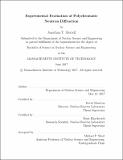| dc.contributor.advisor | David Moncton and Boris Khaykovich. | en_US |
| dc.contributor.author | Morrell, Jonathan T | en_US |
| dc.contributor.other | Massachusetts Institute of Technology. Department of Nuclear Science and Engineering. | en_US |
| dc.date.accessioned | 2017-12-05T16:24:50Z | |
| dc.date.available | 2017-12-05T16:24:50Z | |
| dc.date.copyright | 2017 | en_US |
| dc.date.issued | 2017 | en_US |
| dc.identifier.uri | http://hdl.handle.net/1721.1/112368 | |
| dc.description | Thesis: S.B., Massachusetts Institute of Technology, Department of Nuclear Science and Engineering, 2017. | en_US |
| dc.description | This electronic version was submitted by the student author. The certified thesis is available in the Institute Archives and Special Collections. | en_US |
| dc.description | Cataloged from student-submitted PDF version of thesis. | en_US |
| dc.description | Includes bibliographical references (pages 57-58). | en_US |
| dc.description.abstract | Neutron diffraction is a technique that allows scientists to measure the arrangement and motions of atoms in a crystalline lattice by observing neutrons scattering at angles that are characteristic of the interatomic distances of the crystal. This is useful for studying the response of crystals to stress, irradiation, or for observing their phases. This thesis implements and analyzes a technique known as polychromatic neutron powder diffraction, which has the potential to be used by an instrument to make many simultaneous neutron diffraction measurements. In this experiment, powder diffraction patterns were measured with a diffractometer in polychromatic mode, using both angle-dispersive and wavelength-dispersive scans of a silicon powder. The intensity and resolution of the Bragg peaks with the instrument in this configuration were compared to Bragg peaks measured by the same instrument in a monochromatic configuration. The intensity of the polychromatic mode was only comparable to the monochromatic mode with looser collimation, which had the consequence of increasing the widths of the measured peaks. This resulted in a polychromatic signal intensity that was greater than the monochromatic signal intensity, and a Bragg peak that was wider than the monochromatic Bragg peak. The effects of the collimators and the sample to detector distances were quantified in experiment and in ray-tracing simulations. While both the monochromatic and the polychromatic configurations had similar counting rates in this experiment, they were both limited by the high background due to the open-beam geometry. A successful implementation of a polychromatic instrument would require substantial filtering and shielding to overcome this effect. | en_US |
| dc.description.statementofresponsibility | by Jonathan T. Morrell. | en_US |
| dc.format.extent | 64 pages | en_US |
| dc.language.iso | eng | en_US |
| dc.publisher | Massachusetts Institute of Technology | en_US |
| dc.rights | MIT theses are protected by copyright. They may be viewed, downloaded, or printed from this source but further reproduction or distribution in any format is prohibited without written permission. | en_US |
| dc.rights.uri | http://dspace.mit.edu/handle/1721.1/7582 | en_US |
| dc.subject | Nuclear Science and Engineering. | en_US |
| dc.title | Experimental evaluation of polychromatic neutron diffraction | en_US |
| dc.type | Thesis | en_US |
| dc.description.degree | S.B. | en_US |
| dc.contributor.department | Massachusetts Institute of Technology. Department of Nuclear Science and Engineering | |
| dc.identifier.oclc | 1011352574 | en_US |
